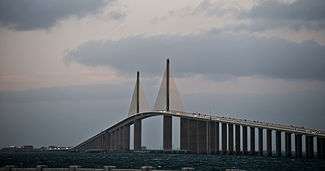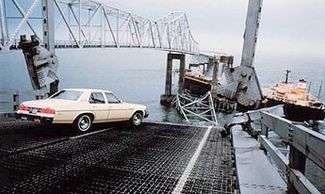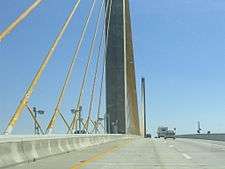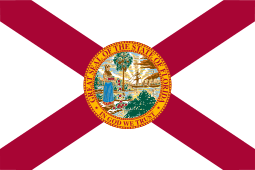Sunshine Skyway Bridge
| Sunshine Skyway Bridge | |
|---|---|
 | |
| Coordinates | 27°37′30″N 82°39′30″W / 27.625°N 82.65833°WCoordinates: 27°37′30″N 82°39′30″W / 27.625°N 82.65833°W |
| Carries |
|
| Crosses | Tampa Bay |
| Locale | South of St. Petersburg and north of Terra Ceia, Florida |
| Maintained by | FDOT |
| ID number | 150189 |
| Characteristics | |
| Design | Continuous prestressed concrete, cable-stayed bridge |
| Total length | 1.1 miles (1.8 km) |
| Width | 94 feet (29 m) |
| Height | 430 feet (131 m)[1] |
| Longest span | 1,200 feet (366 m) |
| Clearance below | 180.5 feet (55 m)[2] |
| History | |
| Opened |
September 6, 1954 (original bridge, collapsed 1980) April 20, 1987 (new bridge) |
| Statistics | |
| Daily traffic | 50,500[3][4][5] |
| Toll | $1.25 for passenger cars or $1.06 with SunPass[6] |
The Sunshine Skyway Bridge, is a bridge spanning Tampa Bay, Florida, with a cable-stayed main span, and a total length of 21,877 feet (4.1434 mi; 6.668 km).[7] It is part of Interstate 275 (I-275) and U.S. Route 19 (US 19), connecting St. Petersburg in Pinellas County and Terra Ceia in Manatee County, Florida, passing through Hillsborough County waters. Construction of the current bridge began in 1982, and the completed bridge was dedicated on February 7, 1987. The new bridge cost $244 million to build, and was opened to traffic on April 20, 1987. It replaced an older bridge constructed in 1954, which was partly destroyed in a collision in 1980.
It is constructed of steel and concrete. Steel cables clad in 84 9-inch (230 mm) steel tubes (42 per pylon) along the center line of the bridge support the main span. It was designed by the Figg & Muller Engineering Group (who also designed the popular Seven Mile Bridge), and built by the American Bridge Company.
In 2005, an act of the Florida Legislature officially named the current bridge the Bob Graham Sunshine Skyway Bridge, after the former Governor of Florida and then U.S. Senator who presided over its design and most of its construction. According to sources, he was inspired to suggest the current design by a visit to France, where he saw a similar cable-stayed bridge, the Brotonne Bridge. The original bridge was dedicated to state engineer William E. Dean, as noted on a plaque displayed at the rest area at the south end of the bridge.
The Travel Channel rated the Sunshine Skyway number 3 in its special on the "Top 10 Bridges" in the World. The bridge is considered the "flag bridge" of Florida.[8]
Because of its height above the emerald-green Gulf waters, length of continuous travel, location in a warm-subtropical climate with palm trees and tropical plants, and modern architectural design, it is a popular spot for filming automobile and other TV commercials.
A major problem with the Sunshine Skyway Bridge is corrosion of the steel in the precast concrete segmental columns on the high level approaches. Because the segments are hollow, workers were able to enter the bridge superstructure in 2003 and 2004 to reinforce the corroded sections of the bridge, ensuring its future safety.[8] Another problem arose around 2005–06 when several news bureaus reported paint discolorations on the bridge's cables. These paint splotches and patches were a result of touch-ups that were performed over the years but began to show through over recent years. In 2008, the Florida Department of Transportation (FDOT) began an overhaul including repainting the cables in their entirety (instead of touching up) and rehabilitating the lighting system at the summit of the bridge.[9]
A 2014 FDOT study noted that the Skyway's low bridge clearance prevented larger vessels from using the Port Tampa Bay terminals, but made no recommendation about options as the air draft of most new cruise ships exceeds the bridge's height limit at 180 feet (55 m).[10]
Original bridge
The present bridge replaced a steel cantilever bridge of the same name. The original two-lane bridge built by the Virginia Bridge Company was opened to traffic on September 6, 1954,[11][12] with a similar structure built parallel and to the west of it in 1969 to make it a four-lane bridge and bring it to Interstate Highway standards. Opening of the newer span was delayed until 1971 for reinforcing of the south main pier, which had cracked due to insufficient supporting pile depth.[13] The second span was used for all southbound traffic, while the original span was converted to carry northbound traffic.
The old bridge replaced a ferry from Point Pinellas to Piney Point. US 19 was extended from St. Petersburg to its current end north.
The remaining approaches to the old cantilever bridge remain in use as Skyway Fishing Pier State Park.
The original Sunshine Skyway Bridge was the site of a number of tragic events, including the collision of the US Coast Guard Cutter Blackthorn and inbound freighter Capricorn in 1980 which claimed 23 Coast Guardsmen's lives,[14] and a structural collapse caused by a collision with the bridge support by the inbound freighter Summit Venture in 1980 which killed 35 people and ultimately ended the bridge spans' useful life.
1980 collapse
The southbound span (opened in 1971) of the original bridge was destroyed at 7:33 a.m. on May 9, 1980, when the freighter MV Summit Venture collided with a pier (support column) during a blinding thunderstorm, sending over 1,200 feet (370 m) of the bridge plummeting into Tampa Bay. The collision caused six cars, a truck, and a Greyhound bus to fall 150 feet (46 m) into the water, killing 35 people.[15][16]

One man, Wesley MacIntire, survived the fall when his pickup truck landed on the deck of the Summit Venture before falling into the bay. He sued the company that owned the ship, and settled for $175,000 in 1984. Mr. Macintire was the last person to drive on the original southbound span, and he died of bone cancer on October 14th, 1989 at the age of 65. [17]
The pilot of the ship, John Lerro, was cleared of wrongdoing by both a state grand jury and a Coast Guard investigation.[18] Soon after the disaster, Lerro developed multiple sclerosis and died in 2002 at the age of 59.[19]
The south main pier (the one that required reinforcement before completion) withstood the ship strike without significant damage. It was the second pier to the south of it that was destroyed, a secondary pier that was not designed to withstand a large ship strike.[13]
After the Summit Venture disaster, the southbound span was used as a temporary fishing pier and the northbound span was converted back to carry one lane in either direction until the current bridge opened. Before the old bridge was demolished and hauled away in barges, MacIntire (the only survivor in the collapse) was the last person to drive over it. He was accompanied by his wife, and when they reached the top of the bridge, they dropped 35 white carnations into the water, one for each person who died in the disaster.[20] Both the main spans of both the intact northbound bridge and the damaged southbound bridge were demolished in 1993 and the approaches for both old spans were made into the Skyway Fishing Pier State Park. These approaches sit 1⁄2 mile (0.80 km) to the south and west of the current bridge. The approaches of the 1950 span were demolished in 2008.
Gov. Graham's idea for the design of the current bridge won out over other proposals, including a tunnel (deemed impractical due to Florida's high water table) and a simple reconstruction of the broken section of the old bridge that would not have improved shipping conditions. The new bridge's main span is 50% wider than the old bridge. The piers of the main span and the approaches for 1⁄4 mile (0.40 km) in either direction are surrounded by large concrete barriers called "dolphins" that can protect the bridge piers from collisions with ships larger than the Summit Venture like tankers, container ships, and cruise ships.[21]
1993 demolition
In 1990 FDOT awarded the winning bid to the Hardaway Company to demolish all steel and concrete sections of the Sunshine Skyway Bridge. The scope of the project required that all underwater piles and piers, and surface roadway, girders, and beams be dismantled. Special care had to be taken in removing underwater bridge elements near the shipping channel. Additionally, the concrete material, deck sections, pilings and steel girders were to be collected in order to be placed offshore and along the remaining bridge approaches to become artificial reefs for the new planned state fishing park. The main bridge span had to be removed in one piece in order not to block the main shipping canal leading to the Port of Tampa.
During the disassembly work of the bridges’ structural steel members, several difficult engineering challenges had to be resolved: the order of disassembly, a safe method for detonating charges on concrete and steel members in a publicly open and difficult to control area such as the Tampa Bay, and the development of a safe methodology for the removal in one piece of the bridge’s main span and concrete piers.
After extensive research, the engineering team developed a 4 × 1:16 ratio pulley system where each of the four corners of the span was connected to two 25-ton winches (bolted to the pavement of the deck). These winches controlled the descent of the main 360-foot (110 m), 608-ton span to a barge anchored 150 feet (46 m) below. As part of the project design, the engineering team developed a real-time, computerized, synchronized descent calculator and control program to help each of the two winch management teams ensure that all winches were synchronized at the same 30 feet (9.1 m) per minute descent rate. The operation was executed successfully in 2 1⁄2 hours despite adverse weather conditions.[22]
Bridge stunts and suicides
Like many famous buildings and structures, many people have engaged in dangerous activity, including jumping to (and attempting to jump) to their deaths. On April 27, 1997, a group of amateur daredevils, led by a bartender from Ft. Lauderdale and composed of a mix of male and female participants, performed an unannounced guerrilla "pendulum swing" bungee jump off the bridge, wherein they planned to swing back and forth on a home-made bungee cord made of steel cable attached to the cast-off point. Arriving by stretch limousine, the group unexpectedly pulled over at the apex of the bridge, quickly rigged up their cable, tethered themselves to it with harnesses, and jumped over the edge. This stunt failed when the plastic sheathing on the steel cable, unable to handle the increase in forces exerted on it by the initial pendulum swing, sheared off and allowed the connecting clamps to slide freely off the cable, plunging the jumpers 60 feet (18 m) into the water, leading to broken bones and neck injuries, but fortunately no deaths. The entire accident was caught on multiple video cameras that had been set up to record the feat.[23][24]
When later interviewed for a television video program, the group's leader stated that all of the components were rated to handle the combined weight of the participants, and, at the time, he thought the assembly was safe. Later studies showed that his design had failed to take into account the increased g-load caused by the pendulum action of the jump, exceeding the ratings on the components and leading to catastrophic failure of the structural integrity of the bungee cable. Since the accident, no other groups have attempted to perform a stunt jump from the bridge. This incident was broadcast on the television program Destroyed in Seconds, on March 2, 2009.
In 2006, a feature film entitled Loren Cass was released, which depicted a suicide jump off the Sunshine Skyway.[25] Two years later, a second filmmaker, Sean Michael Davis of Rhino Productions, was inspired by his haunting experience witnessing a woman jump off the bridge so quickly that no one could intervene, to create a non-for-profit film titled Skyway Down. His objectives: to deter other potential jumpers by " 'punch[ing] them in the face' with interviews with survivors and family members",[26] to give them "hope and to try to de-glorify the romanticism of the bridge",[27] in part by informing those who have "mulled a leap to know about the bloody, battered aftermath."[26]
According to compilations from various media reports as of 2009, at least 207 people have committed suicide by jumping from the center span into the waters of Tampa Bay since the opening of the new bridge in 1987, and an estimated 34 others have tried, but survived. In response to the high number of suicide attempts from the bridge, the state of Florida installed six crisis hotline phones along the center span in 1999, and began 24-hour patrols. As of 2003, the call center at the Crisis Center of Tampa Bay received 18 calls from potential jumpers, all of whom survived, according to a St. Petersburg Times report.[28] However, the total number of jumpers has not significantly declined since the introduction of these safeguards. Corporal Gary Schluter of the Florida State Highway Patrol — who has "seen the number of suicides, and attempts, climb steadily over the last few years" at the Sunshine Skyway Bridge, as well as persuaded multiple would-be suicides at that site to live — advises: "People look at that water and think it's very serene, an easy way to die ... [but] ... it's more like hitting concrete." As he and other troopers explained to The New York Times reporter Rick Bragg, "Jumpers tend to die ugly. [...] The fall, less than four seconds, ends in a bone-snapping, organ-rupturing trauma, but some jumpers do not lose consciousness, and drown in agony." Schluter elaborated: "We retrieve the bodies. They are distorted, mangled."[29]
On October 12, 2009, a body was found in the trunk of a burning car on the Sunshine Skyway bridge. Witnesses saw a man carrying a gasoline can near the car. A Florida Highway Patrol trooper later saw the man jump from the bridge to his death.[30] After an investigation, authorities deemed the deaths a murder-suicide. The jumper, Robert Cecil Laird, shot his ex-wife, Sheryl Laird (39), multiple times at her home in Lakeland before depositing her body in the vehicle's trunk and driving approximately 60 miles (97 km) to the bridge, where he set the car afire and jumped to his death.[31]
Stopping on the bridge for any non-emergency, including sightseeing, is prohibited. As part of a controlled-access highway, pedestrians and bicycles are also prohibited. Traffic on the bridge is remotely monitored by the Florida Highway Patrol, and a stopped vehicle, bicyclist or a pedestrian will elicit a police dispatch.[32]
In popular culture
The original Sunshine Skyway Bridge is featured in the old-time radio series Yours Truly, Johnny Dollar in the episode "The Fancy Bridgework Matter" (November 22, 1959) and in the original opening credits to the 1988 Superboy television series, which showed the hero flying over the damaged original span and then turning to view the new bridge under construction.
Sunshine Skyway Bridge has provided the setting for several films over the years, both credited and uncredited, e.g., Loren Cass and The Punisher
In Ben Bova's 2005 novel Powersat, the Sunshine Skyway Bridge, along with the Brooklyn Bridge and the Golden Gate Bridge were destroyed in a coordinated terrorist attack against the United States.[33]
In 2012, the United States Postal Service featured the bridge on a US$5.15 "Priority Mail" postage stamp. Carl T. Hermann painted it, and the digital illustration was created by artist Dan Cosgrove.[34]
Bill DeYoung's 2013 non-fiction book, Skyway: The True Story of Tampa Bay's Signature Bridge and the Man Who Brought it Down is a detailed chronicle of the 1980 Summit Venture tragedy and its aftermath.[35]
Gallery
Old bridge demolition
-
Before demolition
-

Demolition of steel and concrete girders. Truncated pier visible was the one struck by Summit Venture
-

Main bridge span secure on barge being towed away
-

Blasting steel truss
-

Blasting concrete piers
Current bridge
-

The bridge at twilight
-

View of bridge from Fort De Soto Park's East Beach
-

Driving on the bridge, near the peak
-

View of bridge heading north
-

As seen from the water of Tampa Bay
-
View looking up while driving across Sunshine Skyway Bridge
-
MV Summit Venture Mayday Call of the collision incident
See also
-
 Bridges portal
Bridges portal -
 Florida portal
Florida portal - Skyway Fishing Pier State Park
- Millau Viaduct, France, a later, similar design
- Suicide bridge
References
Notes
- ↑ Bergen, Katy (August 16, 2014). "If Skyway Run Gets Approval, Appeal Could Be Widespread". Sarasota Herald-Tribune. Retrieved May 4, 2015.
- ↑ Dickinson, S.L. (March 25, 2011). "Port Community Information Bulletin # 04-11: Sunshine Skyway Vertical Clearance" (PDF). Archived from the original (PDF) on April 18, 2016. Retrieved November 8, 2016.
- ↑ Pinellas County Metropolitan Planning Organization. 2006 Average Annual Daily Traffic Counts in Pinellas County (A.A.D.T.) (PDF) (Map). Pinellas County Metropolitan Planning Organization. Retrieved January 13, 2008.
- ↑ Florida Department of Transportation. PTMS and TTMS Sites, 2006, Pinellas County (15) (PDF) (Map). Florida Department of Transportation. Retrieved January 13, 2008.
- ↑ "2006 Annual Average Daily Traffic Report" (PDF). Florida Department of Transportation. Site 0088. Archived from the original (PDF) on February 16, 2008. Retrieved January 13, 2008.
- ↑ Maley, Dennis (June 27, 2012). "Sunshine Skyway Reopens with Higher Toll in Effect". The Bradenton Times. Retrieved June 30, 2012.
- ↑ Federal Highway Administration. "National Bridge Inventory Database". Federal Highway Administration. Retrieved September 16, 2011.
- 1 2 Garcia, Jose. "The Skyway Bridge: Yesterday, Today & Tomorrow" (PDF). Florida Department of Transportation. Retrieved March 18, 2007.
- ↑ St. Petersburg Times
- ↑ Kennedy, Sara (July 8, 2014). "Study Offers Options for Cruise Ships Too Tall for the Sunshine Skyway Bridge". Bradenton.com.
- ↑ "Tampa Bay Crossing Spans 14 Miles of Tidewater". Popular Mechanics. August 1954. pp. 72–73 – via Google Books.
- ↑ https://news.google.com/newspapers?id=S5kcAAAAIBAJ&sjid=1GQEAAAAIBAJ&pg=4161%2C1128738
- 1 2 http://interstate275florida.blogspot.com/2009/07/old-sunshine-skyway-bridge.html[]
- ↑ U.S. Coast Guard Cutter History
- ↑ "A Blinding Squall, then Death". St. Petersburg Times. Retrieved February 1, 2007.
- ↑ Heller, Jean (May 7, 2000). "The Day Skyway Fell: May 9, 1980". St. Petersburg Times. Retrieved July 4, 2007.
- ↑ "Suit in Bridge Fall Settlement". The New York Times. May 6, 1984. Retrieved February 1, 2007.
- ↑ Heller, Jean (May 7, 2000). "Memories Stay with Man at Command of the Ship". St. Petersburg Times. Retrieved July 4, 2007.
- ↑ "Pilot in Skyway Disaster Is Dead". All About Multiple Sclerosis. September 3, 2002. Retrieved December 6, 2015.
- ↑ Wright, E. Lynne (2006). Disasters and Heroic Rescues of Florida. Morris Book Publishing. p. 111. ISBN 978-0-7627-3984-4.
- ↑ "Building big: Databank: Sunshine Skyway Bridge". PBS Online. Retrieved July 4, 2007.
- ↑ King, Robert (September 25, 1991). "Chunk of Old Skyway Dismantled". The Bradenton Herald. p. 1B.
- ↑ O'Neil, Deborah (April 28, 1997). "Four hurt in Skyway stunt". St. Petersburg Times. Archived from the original on June 11, 2008. Retrieved March 18, 2007.
- ↑ The Big Swing, Youtube
- ↑ Wilson, Jon (October 11, 2006). "Movie will have its first local viewing". St. Petersburg Times. Retrieved May 28, 2007.
- 1 2 Sanders, Katie (June 13, 2010). "Filmmaker haunted by Sunshine Skyway bridge suicide hopes documentary will deter others". The New York Times. Retrieved September 21, 2012.
- ↑ "Skyway Down: A Permanent Solution to a Temporary Problem; A Film Project". Retrieved September 21, 2012.
- ↑ Jones, Jamie (October 6, 2003). "Skyway Safeguards Don't Deter Jumpers". St. Petersburg Times. Retrieved February 1, 2007.
- ↑ Bragg, Rick (May 9, 1999). "On Florida Bridge, Troopers Are Also Suicide Counselors". The New York Times. Retrieved September 21, 2012.
- ↑ "Body found in trunk of burned car on Skyway". Bay News 9. October 12, 2009. Archived from the original on October 16, 2009. Retrieved September 21, 2012.
- ↑ Poltilove, Josh; Leigh, Jennifer (October 15, 2009). "Body identified as jumper's wife". Tampa Tribune. Retrieved September 21, 2012.
- ↑ http://www.interstate275florida.com/pdf/I275-FAQ.pdf
- ↑ Powersat by Ben Bova, 2005: pp 56-58. TOR Books - New York http://us.macmillan.com/books/9780765348173
- ↑ "Sunshine Skyway Bridge to be on postage stamp". Sarasota Herald-Tribune. December 30, 2011. Retrieved February 27, 2012.
- ↑ University Press of Florida, http://upf.com/book.asp?id=DEYOU001
External links
| Wikimedia Commons has media related to Sunshine Skyway Bridge. |
- Original Sunshine Skyway Bridge at Structurae
- Sunshine Skyway Bridge at Structurae
- Sunshine Skyway Bridge 1986